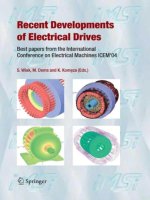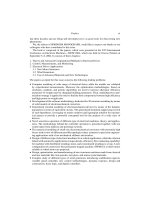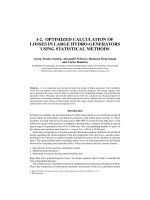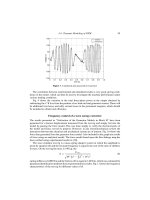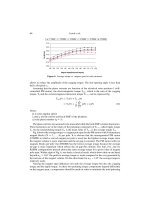Recent Developments of Electrical Drives - Part 25 pot
Bạn đang xem bản rút gọn của tài liệu. Xem và tải ngay bản đầy đủ của tài liệu tại đây (482.52 KB, 10 trang )
II-8. To Determine Natural Frequencies of Electrical Machines 233
Time
(
s
)
Relative response
Vertical current J(1,M)
0
–1
–0.8
–0.6
–0.4
–0.2
0
0.2
0.4
0.6
0.8
1
0.005 0.01 0.015 0.02 0.025 0.03 0.035 0.04 0.45 0.05
Figure 9. Vertical current j
M,N
response (impact excitation).
Fixed structure
Figure 13 presents the mode shapes and the natural frequencies of the statoric ring first in
free condition and then when it is attached.
1
0
1
2
3
4
Magnitude
5
6
7
1000 2000 3000 4000
Frequency (Hz)
FFT
×10
–4
5000 6000 7000 8000 9000 10000
Figure 10. FFT.
234 Lecointe et al.
Figure 11. Suspended stator and meshing.
Figure 12. Experimental results: modes 2-2D, 3-2D, 4-2D and modes 2-3D, 3-3D, 4-3D.
Table 4. Results for the sleek cylinders
Natural frequencies (Hz)
Mode Analytical laws FE Software Analogies Hammer test
Cyl 1
2-2D 2,244 2,232 2,095 2,280
2-3D x 2,808 x 2,740
3-2D 6,208 6,169 6,395 6,280
3-3D x 7,155 x 6,930
Cyl 2
2-2D 756 824 799 742.6
2-3D x 1,454 x 1,350
3-2D 2,102 2,295 1,899 2,060
3-3D x 3,752 x 3,470
4-2D 3,940 4,301 3,700 3,860
4-3D x 6,278 x 5,810
5-2D 6,200 6,761 6,318 6,060
5-3D x 8,976 x 8,230
II-8. To Determine Natural Frequencies of Electrical Machines 235
Free stator
Mode 2-2D : 912 Hz
Mode 2-3D : 1300 Hz
Mode 3-2D : 2480 Hz
Mode 3-3D : 3010 Hz Mode 4-3D : 3020 Hz
Mode 4-2D : 2480 Hz
Mode 2-3D : 1330 Hz
Mode 3-2D : 944 Hz
Fixed stator
Figure 13. Mode shapes and natural frequencies.
In free mode, the three first modes are perfectly identified. However, some modes are
not as perfectly defined as for the sleek cylinders. For example, the shape of the mode 2 in
two dimensions is undoubtedly deformed by the welded feet.
When the stator yoke is fixed to the chassis, the natural frequencies are increased but the
maximal relative variation is equal to 5.2%. This evolution is attributed to the fixation of
the structure. If the natural frequencies are not modified a lot, the mode shapes differ from
the shapes observed in free mode. For example, the modes 3-2D and 3-3D in free mode
become almost modes 4-2D and 4-3D when the structure is fixed. The fixation prevents the
structure from moving. It is clearly visible at presented pictures.
236 Lecointe et al.
Conclusion
In this paper, four different methods to determine the mechanical behavior of cylinders—
sleek orequipped offeet—have beenstudied. Analytical and analogy methodsgive accurate
results butthe FEsoftwarekeeps theadvantageof the3Dmode determination.The extended
Jordan’s laws allow to find very quickly the 2D radial frequencies with a simple computer
whereasothers methods requiresspecific software ormodal analysis equipment.In thisway,
the analytical method can be used for a first diagnosis.
Thus, analytical laws can still be used to determine the natural frequencies of fixed
electrical rotating machines. Indeed, frequencies in both cases are very close. However, it
has been shown that the mode number is different. Such a modification can influence the
determination of noise emitted by electrical machines. Indeed, analytical theories [9] of
noise prediction consider non-fixed structure as a cylinder of infinite length or a vibrating
sphere. Consequently, the next step willstudy the influence ofthe machine fixation onnoise
emission. At last, the analogy method will be extended to the third dimension.
References
[1] P. Fran¸cois, “La g´en´eration desbruits et la r´eponse desstructures dans les moteurs asynchrones,
en particulier en ce qui concerne les ´ecoulements”, Revue G´en´erale de l’Electricit´e, Avril 1968,
pp. 377–392.
[2] B. Cassoret, R. Corton, D. Roger, J F. Brudny, Magneticnoise reductionof inductionmachines,
IEEE Trans. Power Electron., Vol. 18, No. 2, pp. 570–579, 2003.
[3] D.E. Cameron, J.H. Lang, S.D. Umans, The origin and reduction of acoustic noise in doubly
salient variable-motors, IEEE Trans. Ind. App., Vol. 28, No. 6, November/December, pp. 1250–
1255, 1992.
[4] C. Couturier, B. Cassoret, P. Witczak, J F. Brudny, “A Contribution To Study The Induction
Machine Stator Resonance Frequencies”, ICEM 98, Vol. 1, Istanbul, Turkey, September 2–4,
1998, pp. 485–489.
[5] W. Cai, P. Pillay, Z. Tang, Impact of stator windings and end-bells on resonant frequencies
and mode shapes of switched reluctance motors, IEEE Trans. Ind. App., Vol. 38, No. 4,
pp. 1027–1036, 2002.
[6] S.P. Timoshenko, J.N. Goodier, Theory of Elasticity, 3rd student edition, McGraw-Hill Compa-
nies, New York, 1970.
[7] H. Jordan, Ger¨auscharme Electromotoren, Essen: W. Girardet, 1950.
[8] J Ph. Lecointe, R. Romary, T. Czapla, J F. Brudny, Five methods of stator natural frequencies
determination. Case of induction and switched reluctance machines, Mechanical Systems and
Signal Processing, Elsevier, Vol. 18, pp. 1133–1159, 2004.
[9] Ph.L. Alger, The magnetic noise of polyphase induction motors, Trans. Amer. IEEE, Pt. III A,
No. 73, pp. 118–125, 1954.
II-9. DIAGNOSIS OF INDUCTION
MACHINES: DEFINITION
OF HEALTH MACHINE
ELECTROMAGNETIC SIGNATURE
D. Thailly, R. Romary and J.F. Brudny
CNRT Futurelec 2—R´eseaux et Machines Electriques du Futur, Laboratoire Syst`emes
Electrotechniques et Environnement—Universit´e d’Artois, Facult´e des Sciences Appliqu´ees,
Technoparc Futura, 62400 B´ethune, France
, ,
Abstract. This paper deals with the diagnosis of induction machines using data contained in the
radial external magnetic field. This work presents a theoretical approach which permits to study the
evolution of each flux density air-gap component through the stator. The aim of this method is to
find, by computation, the magnitude of measured spectral lines. The study is made on the couples of
toothing spectral lines and justifies why these couples do not have the same magnitude, what is not
obvious in a first approach where the practical spectrum is directly compared with this one of the
air-gap flux density.
Introduction
From an economical point of view, it appears that, for a factory, predictive maintenance of
electrical machines is essential. Various procedures have been brought [1,2], and it should
be noted a recent orientation in the exploitation of data enclosed in magnetic field (MF)
which surrounds the machine. It was display that is advisable to dissociate two cases: the
axial MF [3], which principally corresponds to the coil end leakage of ar mature winding,
and the radial MF [4], which is the subject of our research.
Previousstudies [5]have shown thatit isnecessary to distinguish two frequency domains
ofthe radialMF accordingto theskineffectwhichappears inthe magneticsheets.This paper
is restricted to low frequency components induced by slot effect in induction machines. The
aim is to investigate the flux density evolution through the stator frame to determine a
correspondence between the flux density in the air-gap and the one which appears at the
measured point outside the machine.
This paper presents first, the theoretical approach, then, the principle of measurement of
the radial MF, and finally, the comparison between results deduced from experimental tests
and these ones obtained by analytical computations.
S. Wiak, M. Dems, K. Kom
˛
eza (eds.), Recent Developments of Electrical Drives, 237–246.
C
2006 Springer.
238 Thailly et al.
Analytical expression of the air-gap flux density
The analytical expression of the normal air-gap flux density b
g
is achieved by multiplying
the expressionof themagneto-motive force(m.m.f.) whichappears atthe limitof theair-gap
by this one of the air-gap permeance per surface unit.
To reduce the developments, it is assumed that the magnetic effects are only created by
the threephase p pole pairstator which windingsare crossedbythe currents i
q
(1 ≤ q ≤ 3).
Taking the stator phase 1 axis as spatial reference and locating any point of the air-gap by
the variable α, the m.m.f. expression ε(α), assuming first infinite the iron permeability, is
given by the following relation:
ε(α) =
3
q=1
i
q
+∞
hs=1
hs uneven
A
hs
cos
hs
pα −(s − 1)
2π
3
(1)
where s is the slip.
Considering that the m.m.f. evolutes in a linear way on the slot width leads to defines
A
hs
by the expression:
A
hs
=
2z
πhs
(−1)
hs−1
2
sin
(1−rds)π
pN
s
hs
(1−rds)π
pN
s
hs
sin
hsπ
6
m sin
hsπ
6m
(2)
where rds is the ratio of the slot width to the slot step, N
s
is the number of stator slots per
pole pair, z is the total number of turns for one stator phase under a pole pair, and m is the
number of slots per pole per phase.
The used expression of the permeance per surface unit, takes the stator and rotor slotting
effectsinto accountseparately but, alsothe interactionbetween theboth [6]. Sothis quantity,
function of α but also of θ which represents the angular displacement between the stator
and rotor references, can be written as:
p(α, θ ) =
+∞
ks=0
+∞
kr=−∞
P
kskr
cos
[
(
ksN
s
− krN
r
)
pα +krN
r
pθ
]
(3)
N
r
represents the bars number per pole pair, P
kskr
is a term which depends on the machine
geometry, and ks and kr are two integers.
Let us assume that the stator is supplied by a balanced three phase sine currents of I
r.m.s value and ω angular frequency. It results that:
θ = θ
0
+ (1 − s)
ω
p
t (4)
Choosing a temporal origin such as, for t = 0, i
1
= I
√
2 and θ
0
= 0, leads to
b
g
=
hs
+∞
ks=−∞
+∞
kr=−∞
ˆ
b
g
hs
ks,kr
cos{[1 + krNr(1 − s)]ωt − (hs +ksNs + krNr)pα} (5)
with:
ˆ
b
g
hs
ks,kr
=
3I
√
2
2
A
hs
P
kskr
(6)
II-9. Diagnosis of Induction Machines 239
ext
Rs
R
OTOR
AIR-GAP
STATOR
int
Rs
r
bn
bt
M
b = 0
b
A
Figure 1. Section of the machine.
hs is an integer equal to 6 ν +1 where ν is a positive, negative, or null integer. Expression
(5) can also be expressed with the following form:
b
g
=
+∞
h=−∞
+∞
k=−∞
ˆ
b
g
h,k
cos(kωt − hpα) (7)
where:
k = 1 +krNr(1 − s) (8)
h = (hs +ksNs +krNr) (9)
It has been shown [7] that this method defines precisely the frequencies and gives satis-
factory results in the magnitudes.
Evolution of the flux density through the stator
In order to establish the analytical expression of the flux density
b,in the surrounding of the
machine, at M point, it is necessary to study its evolution through the stator frame. Fig. 1
presents a section of a machine.
Rs
int
and Rs
ext
are the interior and exterior stator radii, and r is the distance of the sensor
from the motor shaft. The relative magnetic permeability of the stator iron is denoted μ
r.
To determine the diffusion of the flux density through the stator [8], it is required to
exploit the Maxwell equations:
Div
b = 0, which describes the conservative aspect of the flux density,
Curl
h =
j which is the local expression of the Ampere theorem
240 Thailly et al.
where
b,
h, and
j are, respectively, theflux density, themagnetic field, and thecur rent density
vectors.
The equations will be solved in the stator iron and in the external air. So, as there is no
current in these areas, it comes:
Curl
h =
0 (10)
The flux density vector
b can be expressed using the definition of the magnetic vector
potential
A, as well as:
b =
bn
bt
0
= Curl
A (11)
so:
Curl
h = Curl
1
μ
0
μ
r
Curl
A
= 0 (12)
As
A is only in the axial direction, equation (12) amounts, consequently, to resolve:
∂
∂r
r
∂ A
∂r
+
∂
∂α
1
r
∂ A
∂α
= 0 (13)
This equation admits one solution which has the following form [9]:
A =
+∞
ς=0
λ
1
r
ς
+ λ
2
r
−ς
sin ς(α −α
) (14)
Identification with equation (7) leads to ςα
= kωt and, as the sign of the flux density pole
number is just significant of the rotating sense of the component: ς =|h|p.
It is also possible to obtain the nor mal and tangential components of the flux density
vector:
⎧
⎪
⎪
⎨
⎪
⎪
⎩
bn
h,k
=
1
r
∂A
∂α
=
ˆ
bn
h,k
cos
(
|
h
|
pα −kωt
)
bt
h,k
=−
∂A
∂r
=
ˆ
bt
h,k
sin
(
|
h
|
pα −kωt
)
(15)
So:
ˆ
bn
h,k
=
|
h
|
p
r
λ
1
r
|
h
|
p
+ λ
2
r
−
|
h
|
p
ˆ
bt
h,k
=−
|
h
|
p
λ
1
r
|
h
|
p−1
− λ
2
r
−
|
h
|
p−1
(16)
It can be noticed that these equations are valid whatever the area.
In the following, the upper indexes “g,” “i,” or “a” will be used to distinguish different
variables related to, respectively, air-gap, iron and external air areas.
In the air
According to the flux density equals zero when r tends toward infinity, leads to:
λ
a
1
= 0 (17)
II-9. Diagnosis of Induction Machines 241
Equation system (15) becomes:
bn
a
h,k
=
|
h
|
pλ
a
2
r
−
|
h
|
p−1
cos
(
|
h
|
pα −kωt
)
bt
a
h,k
=
|
h
|
pλ
a
2
r
−
|
h
|
p−1
sin
(
|
h
|
pα −kωt
)
(18)
It can be noticed that the normal component magnitude of the flux density is equal to the
tangential one.
In order to determine the second coefficient λ
a
2
, it is necessary to know the magnitude
of the flux density at the boundary r = Rs
ext
. At this point, if the value of the flux density
components is noted
ˆ
b
a
h,k
(r=Rs
ext
)
it comes:
λ
a
2
=
ˆ
b
a
h,k
(r=Rs
ext
)
|
h
|
p(Rs
ext
)
−
|
h
|
p−1
(19)
Then, the equations of the flux density in the air are given by:
bn
a
h,k
=
ˆ
b
a
h,k
(r=Rs
ext
)
(r
)
−
|
h
|
p−1
cos
(
|
h
|
pα −kωt
)
bt
a
h,k
=
ˆ
b
a
h,k
(r=Rs
ext
)
(r
)
−
|
h
|
p−1
sin
(
|
h
|
pα −kωt
)
(20)
with:
r
=
r
Rs
ext
(21)
In the stator
On the iron-air boundar y (r
= 1), the nor mal component of the flux density is preserved
as well as the tangential one of the magnetic field:
ˆ
bn
i
h,k
(r=Rs
ext
)
=
ˆ
b
a
h,k
(r=Rs
ext
)
ˆ
bt
i
h,k
(r=Rs
ext
)
= μ
r
ˆ
b
a
h,k
(r=Rs
ext
)
(22)
Going back to the developed Maxwell equations (15), it can be written, for r =1:
⎧
⎪
⎨
⎪
⎩
ˆ
b
a
h,k
(r=Rs
ext
)
=
|
h
|
p
Rs
ext
λ
i
1
Rs
|
h
|
p
ext
+ λ
i
2
Rs
−
|
h
|
p
ext
μ
r
ˆ
b
a
h,k
(r=Rs
ext
)
=−
|
h
|
p
λ
i
1
Rs
|
h
|
p−1
ext
− λ
i
2
Rs
−
|
h
|
p−1
ext
(23)
The resolution of the system (23) leads to the following expressions of λ
i
1
and λ
i
2
.
λ
i
1
=
(1 − μ
r
)
ˆ
b
a
h,k
(r=Rs
ext
)
2
|
h
|
pRs
|
h
|
p−1
ext
(24)
λ
i
2
=
(
μ
r
+ 1
)
ˆ
b
a
h,k
(r=Rs
ext
)
2
|
h
|
pRs
−
|
h
|
p−1
ext
(25)
242 Thailly et al.
Assuming that μ
r
1, the evolution equations of the flux density through the stator are
finally express as following:
⎧
⎪
⎨
⎪
⎩
bn
i
h,k
=
μ
r
2
ˆ
b
a
h,k
(r=Rs
ext
)
(r
)
−
|
h
|
p−1
− (r
)
|
h
|
p−1
cos
(
|
h
|
pα −kωt
)
bt
i
h,k
=
μ
r
2
ˆ
b
a
h,k
(r=Rs
ext
)
(r
)
−
|
h
|
p−1
− (r
)
|
h
|
p−1
sin
(
|
h
|
pα −kωt
)
(26)
As, in this approach, it is the magnetic field radial component which is considered, it is just
necessary to continue the study on the normal component of the flux density.
In this case, as the normal flux density is preserved on the boundary between the air-gap
and the stator and since this one can be obtained by the equation (7), it is consequently
possible to establish a link between the flux density which exists in the air-gap and this
which flows at the outside of the machine.
If r = R
s
int
, then
ˆ
bn
i
h,k
(r=Rs
int
)
=
ˆ
b
g
h,k
So, it can be deduced:
ˆ
b
a
h,k
(r=Rs
ext
)
=
ˆ
b
g
h,k
μ
r
2
Rs
int
Rs
ext
−
|
h
|
p−1
−
Rs
int
Rs
ext
|
h
|
p−1
(27)
From equation (20), it can be defined the K
h
(r)
coefficient which takes into account the
decreasing of the magnitude of each component, regarding to its number of pole pair:
K
h
(r)
=
ˆ
bn
a
h,k
ˆ
b
g
h,k
(28)
K
h
(r)
= Kr
−
|
h
|
p−1
(29)
where K is a constant coefficient equals to:
K =
2
μ
r
Rs
int
Rs
ext
−
|
h
|
p−1
−
Rs
int
Rs
ext
|
h
|
p−1
(30)
It can be noticed that the higher |h| is, the more rapidly K
h
, and consequently, the corre-
sponding component magnitude, decreases regarding its values in the air-gap.
Measured flux
In order to measure the radial magnetic field in the surrounding of the machine, a coil, used
as a flux sensor, is set, in a plan parallel to the shaft, as it is shown on Fig. 2.
The 2β angle corresponds to the angular size of the sensor from the motor shaft (ls ≈
2βr). The sensor length Ls is sufficiently small with regard to this of the machine L, so that
the developed theory remains valid even the bars are skewed.
The flux
h,k
, linked by thissensor, is tiedto theexternal normal fluxdensity component
depending on its geometry.

